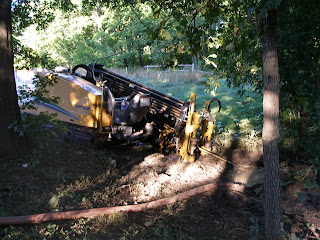SouthWoods featured in Permaculture Magazine

This is an excerpt from the article I wrote.
Each issue is filled with great case studies and techniques.
Catching Water
The first principle in Permaculture is Observation. My first observation when we bought our homestead in 2003 was the loss of rainwater to our wetlands and the dry clay soils left behind. The topography had just enough slope to create sheets of flowing water during heavy rainstorms. Even though we were surrounded by wetland, the soils a short distance away was hard and dry. It was an opportunity to catch and store rain water with the classic swale and berm technique. The grassy hill would soon be filled with fruiting trees and shrubs.
We had a 50 x 150 foot area where the water flowed down a 30% slope and crossed our gravel driveway. Keeping that water on the land and using it for perennial crops was our goal. My local Permaculture Collaborative was also looking for a demonstration site for a summer workshop and implementation. With that we had expertise, resources and the energy of the members to make our goal a reality.
Sinks and Sources
In the realm of natural resources we have sources and we have sinks. The sources are sun, sky and soil. The energies of sunlight, rain water and soil biology. The sinks are where resources are lost or out of reach. It is the space between source and sink that we try and fill with functions. We try and keep these energies at work as long as possible. Putting the resource to work doing multiple functions we: Divert, Intercept, Delay, Absorb, Replace, Slow, Infuse, Infiltrate, Leverage, and Contain. The more times I can use water before it leaves the property, the less water I need to source. Catch and Store has become our most useful principle and at the same time incorporates all the other principles.
Our roof and driveway were our best collectors of rainwater. Gutters were added to the house and garage. These direct water to buried drain tile pipe, which brings the water to a 30x40x10 foot clay based pond. An overflow pipe off the pond fills the swales as excess pond water overflows. Three foot wide and eight-inch deep swales use six foot wide level spillways to deter erosion. Water a few millimeters deep spills to the next lower swale until it fills and spills to the next. The water in the swale soaks the ground and berms creating a water lens increasing the available water to plants over long periods.
To retain enough rainwater to supply our orchard we needed large swales to catch the now infrequent rains. Climate change is taken into account since long drizzling rains are infrequent and rain now comes as sudden down pours. We needed a system that can catch thousands of gallons of rainwater and store it for the many weeks of drought. Although the clay soil keeps the water from soaking in quickly, it also holds the water tightly. Surprisingly clay needs as high an infusion of water as sand. Sand drains away quickly and needs frequent watering, but clay requires a higher water volume for the water to be available to plants. The berms in the orchard, rich in organic matter, absorb the available water like sponges. The clay, rich in minerals, holds the water below for the deep roots to tap as needed.
We have the best of both worlds.
With Permaculture designers Paula Westmoreland, Guy Trombley and the visiting Aussie Geoff Lawton, we devised a regenerative system to catch the rainwater and at the same time build the soil to contain it. Plant Polycultures, ala Paula, filled the three 150 foot berms with 45 fruiting trees and shrubs, perennials and ground cover. Geoff and Guy supervised and guided the 20 ton excavator as it dug the pond and level swales I had staked out the previous week. The swale soil was mounded and shaped along the downhill side for the berms. On the second day of the implementation 24 Collaborative members descended on the site for a “Work & Learn” workshop. Geoff and Guy gave presentations explaining the earthworks and Paula and I described the plant guilds being used. By evening all the plants and micro-drip irrigation was installed and the hill was covered with mulch.


Comments